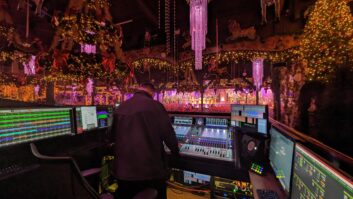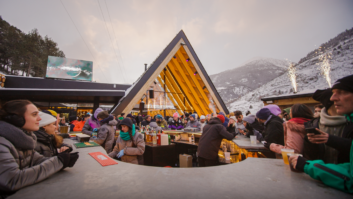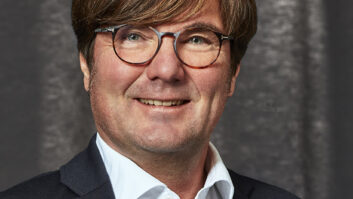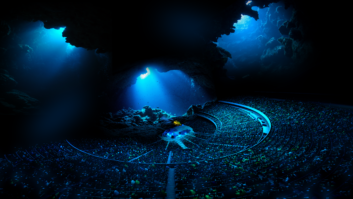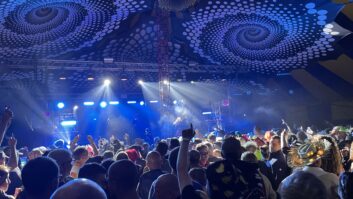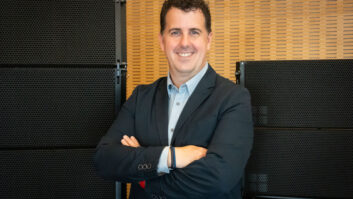I’m generally a little wary of invitations to go off site during tradeshows. The whole point of shows is to have a large number of companies all under one roof; leaving the exhibition centre inevitably takes up a larger chunk of your time, which is generally at a premium. Also, you tend to be held to your host’s timetable when they are organising the transport. (This is especially true for events held on boats.)
However, d&b audiotechnik’s invitation to the launch of the GSL loudspeaker system during Prolight + Sound had promised “if you have any interest in electroacoustics, it will be worth it”, so I put such misgivings aside and accepted.
Our venue was the Jahrhunderthalle, a concert and convention centre about 10km west of Frankfurt Messe. Dating from the 1960s, this venue has hosted many musical greats over the years, including Louis Armstrong (1965), Jimi Hendrix (1969) and Leonard Cohen (1970). Interestingly, French singer Mireille Mathieu, who first played there in 1968, was due to return in a couple of weeks’ time.
Once inside, it became apparent why the trip out of the Messe had been necessary. Not only did the demo occupy most of the auditorium, but also the manufacturer had invited hundreds of guests to the launch. Also, GSL (the name apparently comes from ‘grosse speziale Lautsprecher’– large special speakers) has been created for the largest sound reinforcement applications.
Increased headroom
We began with a presentation, by Janko Ramuscak from d&b EAS (education and application support), about the design of the GSL line array system, which is part of d&b’s SL-Series and sits right at the top of the company’s loudspeaker product range. A key design aim was to increase headroom while also keeping sound immission under control. (Immission, by the way, is a word I have only heard used by d&b – perhaps unsurprisingly as it is the same word in German; as I understand it, it refers to sound that reaches the human ear, particularly sound that is unwanted.)
Ramuscak explained that the lowest octaves are the hardest to control, without making the speaker cabinet impractically large. So instead, the line array modules feature cunning geometric design that takes into account acoustic path lengths from port to port and from cone to cone – so that audio signals reinforce at the front of the cabinet and cancel out at the rear.
The GSL8 (80º horizontal dispersion) and GSL12 (120º) modules each feature two 14in LF drivers mounted at the front, and two 10in LF drivers at the sides – but the shape of the sound is almost the same as if all four drivers were at the front. The mid-range is handled by a horn with a 10in driver, and there are three HF drivers (with a 1.4in exit and 3.4in voice coil). Each cabinet uses two amplifier channels – one for the front-facing 14in drivers, and one for all the other elements.
The result is a loudspeaker that offers accurate directivity control down to 45Hz, and for many applications does not need to be supplemented by a subwoofer. (The series does include two subs, though: the GSL-SUB for flown applications and the GSL-GSUB for groundstacking.)
Configurations
The proof of this particular pudding comes in the listening, of course, and the GSL series was demonstrated in a number of configurations: first, a single hang of eight GSL8 and two GSL12; then two such hangs in a left-right configuration; and finally with the addition of 12 GSL-GSUBs, stacked in pairs on the floor with a single outlier on each side. We were encouraged to walk around the auditorium and around the speakers as various styles of music were played.
With the mono hang, my chest was vibrating as I stood about 4m in front – but I could stand right behind it comfortably; no sound appeared to be coming from the speakers themselves. During the second part of the demo, I walked around the auditorium and found the coverage to be very even across many tiers of seats. For the final part, with the subs, some guitar music made my scalp tingle when I got as close as I dared to the front of one of the arrays; but approaching from behind, the music didn’t get any louder.
All in all, this was a very impressive demonstration. The GSL System’s sound quality was of course excellent, and the way the sound is directed away from where it is not needed – avoiding potential problems with unwanted reflections or transmission to adjoining buildings – is a property that many users will be interested in. The promise in the invitation was right – the demo was certainly worth leaving the Messe for.
